Scroll through the lesson and click on notation/video/audio links to load the interactive players.
Please subscribe to get full access to all lessons for only $7.95/month PLUS 1 week free trial.

Riff Interactive lessons are
LESS expensive and
MORE interactive than alternatives!
More Info
|
|

Beginning Guitar
III - Lesson 1
Open Position Dominant Chords Lyle: Before you start with this lesson, please
check your tuning:
check your
tuning
Lyle: In the past
few lessons you have learned the basic open position major and minor chords. Now
it's time to learn the "dominant 7" chords in the open
position.
Lyle: The
"dominant" chord has a bluesy sound to it compared to the other major and minor
type of chords.
Lyle: Start by learning the
A7:
A7
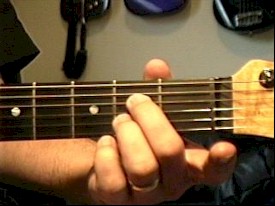
A7
Lyle:
Here's a picking pattern to try with this chord. The "v" means down stroke with
the pick, the "^" is an up stroke:
A7 picking pattern
A7 picking
pattern
Lyle:
The "dominant" type of chord is made from a major triad (1 - 3 - 5) followed with a flatted
7th (b7) degree. You don't need to know this but that's the musical theory of
the chord. Impress your friends with this knowledge ;-)
Lyle:
Here's a looping jam track of a drum beat you can use as a sort of metronome to
practice the picking pattern with:
metronome drum track
Lyle:
Don't worry if the theory and terminology throws you off, just memorize what
you're playing for now.
Lyle: Next is the C7
chord:
C7
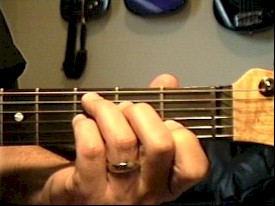
C7
Lyle:
Here's a picking pattern you can use to practice the C7 chord
with:
C7 picking
pattern
C7 picking
pattern
Lyle: Remember to
follow the correct pick direction so that you learn to sound smooth and even
with these simple picking patterns.
Lyle: Next is the D7 chord which only uses 4
strings, just like the D and Dm chords:
D7
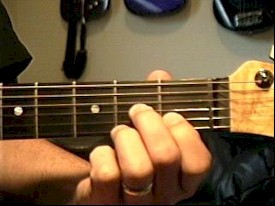
D7
Lyle:
Now try this picking pattern I made for the D7 chord:
D7 picking
pattern
D7 picking
pattern
Lyle:
Remember you can use the looping jam track of the basic drum beat to practice
keeping a steady beat with.
Lyle: Now a big 6 string chord, the
E7:
E7

E7
Lyle: Here's a picking pattern for you to try
with the E7:
E7
picking pattern
E7 picking
pattern
Lyle: I
find it difficult to get the open 4th string to ring clearly. This is an
important note because it is the "flatted 7th" degree and the reason why the E7
chord sounds bluesy.
Lyle: Try to get your 2nd finger to roll up on
its tip and out of the way of the open 4th string when playing this E7
chord.
Lyle: Last but not least, the G7
chord:
G7
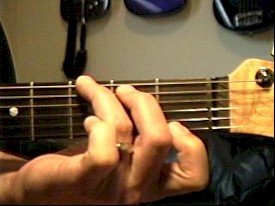
G7
Lyle:
Now try this picking pattern for the G7 chord:
G7 picking
pattern
G7 picking
pattern
Lyle:
Now I've put together a 8 measure progression using these dominant 7 chords.
Notice how "bluesy" they all sound. You'll use the strum pattern that you used
from the last couple of lessons. Here's the chord
progression
blues
chord progression
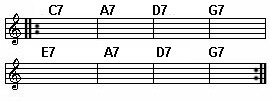
blues progression
blues
progression
Lyle:
Learn how to play that progression all the way through and be able to repeat it.
Here's a blues drum beat to help you keep a steady beat
with:
blues drum
track
Lyle:
That's your goal for this lesson, to be able to play this blues progression a
few times through with the jam track.
Lyle: Any questions?
sammy_andrews: Yes, what scales would you use to play over
these dominant chords??
Lyle: Well, there are so many to choose from. I
would use the diminished/whole tone scale also known as the Phrygian Dominant.
You could use the minor pentatonic for a real bluesy sound or try the Mixolydian
mode for a melodic sound. More about scales in the near future....stay
tuned!
sammy_andrews: Ok thanks,... I was just trying to think
if minor or major scales would work over dominant chords..is
all
Lyle:
good question though...
sammy_andrews: I'm not trying to get ahead of you,,, was
just wondering... :o)
david_reid: what's the difference between Phrygian and
Phrygian dominant?
Lyle: Scales are a whole 'nother beast to deal
with. We must first learn to walk before we can
run...grasshopper.
david_reid:
hahaha
sammy_andrews: yes master ...lol
Lyle: ;-)
Joel: :)
Lyle: Let's
take a break for now. Thanks everyone for being here live tonight and for your
good questions. We'll work on scales soon enough. That's all for this lesson.
Have fun, practice hard, and see you at the next lesson!
|
<< load notation from left
|
|
<< load audio from left
|
<< load audio from left
|